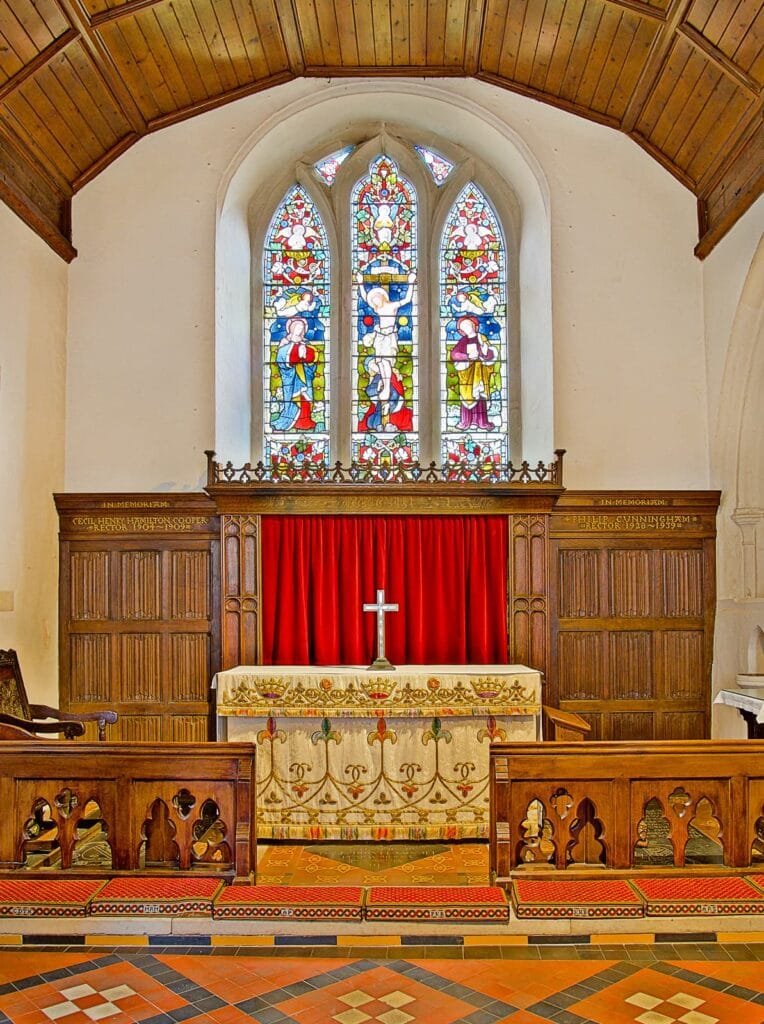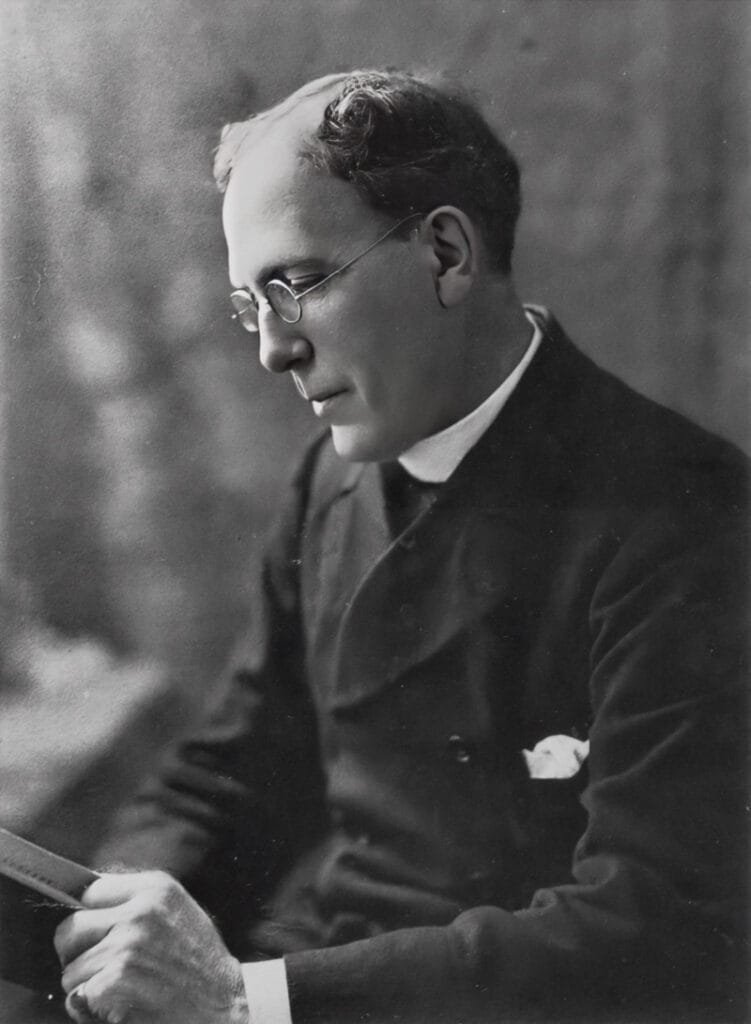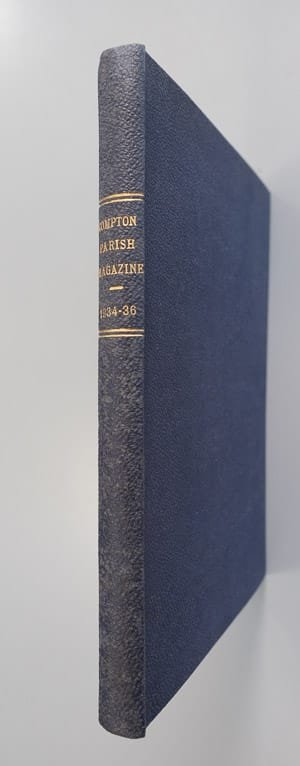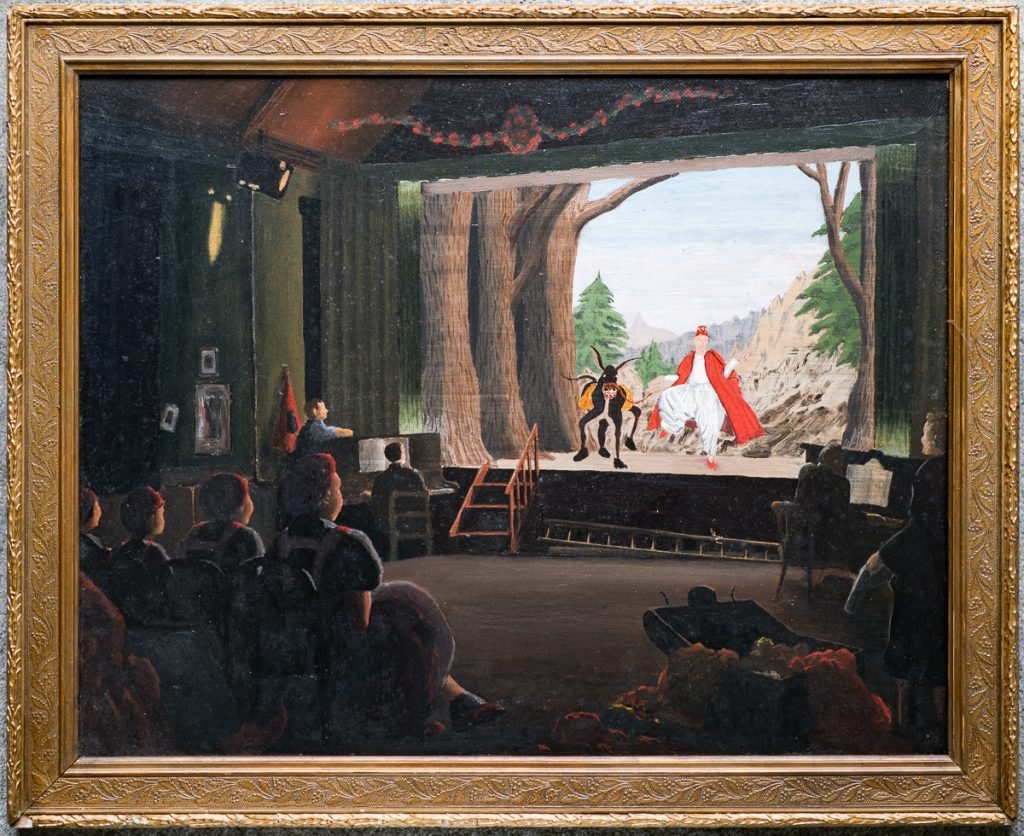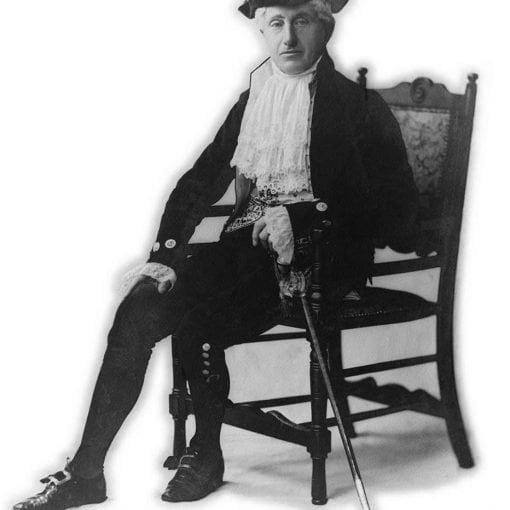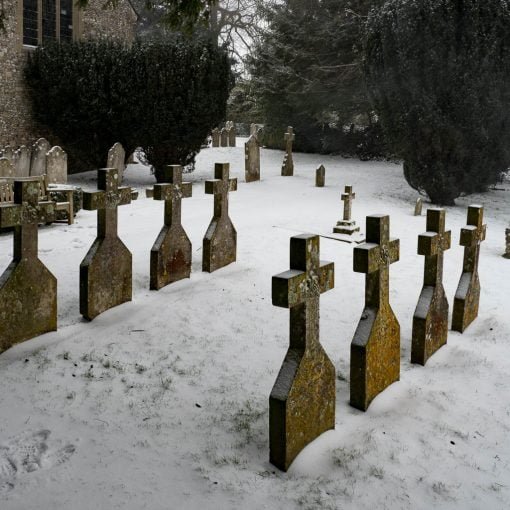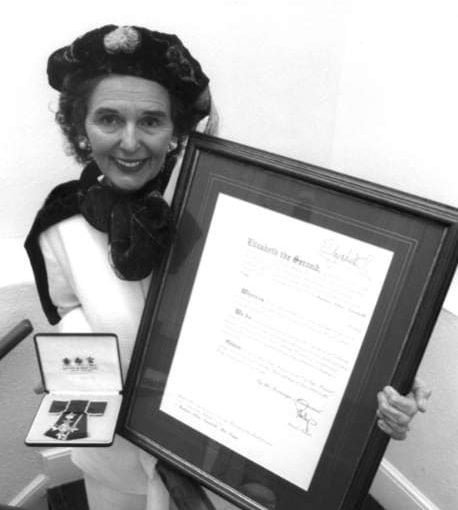14 July 1866 – 9 February 1942
Part 3 of the series on the Cooper-Cunningham memorial[1]Part 1 The Cooper and Cunningham Memorial (this website)[2]Part 2 Dean Cecil Cooper, Rector of Compton 1904-1909
Reprinted, with minor corrections and clarifications, from the February 2025 issue of Compton & Shawford Parish Magazine
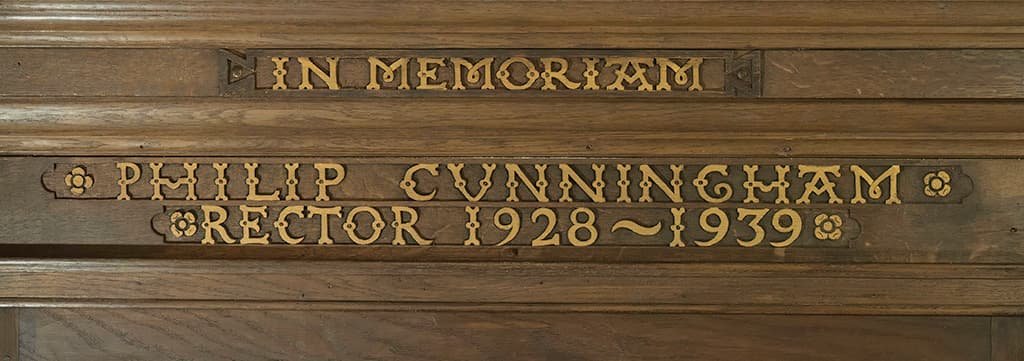
It’s appropriate that Philip Cunningham and Cecil Cooper are commemorated together on the oak panelling behind the altar in the old Norman side of All Saints Church Compton.
Both made huge and lasting contributions to our church. They were quite close in age, Philip Cunningham being about five years older. They died within a few weeks of each other in early 1942.
They both came from clerical families.
But there are differences.
For Cecil Cooper, this was his first living. He was just 32 when he arrived here and was thrust into Compton church’s extend or new build controversy.
He went on, via St. Thomas in Winchester, to become Vicar of St. Mary’s, Scarborough, then Archdeacon of York. He was Dean of Carlisle from 1933 to 1938 before retiring, as he had always intended, to Compton.
Born in Newfoundland, Philip Cunningham was a reverse immigrant.
His father John had been born in Stepney in 1823. He had answered the call to Newfoundland where he served as priest in Burgeo for nearly 50 years, and is buried there in the St. John the Evangelist Anglican Churchyard Cemetery. The Rev. John Cunningham was a dedicated educator with a magnificent voice and a strong advocate for physical activity. He ran an exemplary school and encouraged athletics and outdoor sports, unlike some of his fellow clergy. He was an exceptional marksman, particularly with shotguns, and his skill was so renowned that local competitions often excluded him.
Philip, his youngest child, was sent back to England for education and only returned to Newfoundland for occasional family visits.
Philip had just turned 62 when he arrived at Compton, already a highly experienced and senior priest, as Rural Dean of Guildford and having been Rector of Cranleigh for 22 years. Compton was his last living before retirement.
Cunningham’s Contribution
It must have been Philip Cunningham who started the archive of Parish Magazines, such a valuable resource for students of local history. Although the magazine had been started many years earlier, the issues in the Hampshire Records Office begin in 1928 with neatly bound volumes, coinciding with Cunningham’s arrival at Compton.
His monthly letters in the parish magazine give us much information about life in the parish, and he encouraged J.S. Drew to contribute historical papers to the magazine.
At his retirement party in 1939, G. R. Crawford[3]George Crawford and the Festival Choir recalled that when Canon Cunningham became Rector of Compton he also became Rural Dean of Winchester. He was subsequently made an Honorary Canon of Winchester Cathedral, being the first Rector of Compton to attain that honour.
During his incumbency he had been responsible for the raising nearly £1000 (worth £57,000 in 2024) towards the additional endowment of the living; the old Rectory had been sold, a new Rectory, more suited to the income of the living, had been built; and electric light[4]The Verger’s Tale had been brought into the church.
The Rectory house and garden had been a real parochial home, always open for meetings, entertainments and the like.
Death of Canon Philip Cunningham
from the Hampshire Chronicle 14 February 1942
We record this week, with regret, the death of Canon Philip Cunningham, for many years Rector of Compton, near Winchester, Rural Dean of Winchester, and Hon. Canon of Winchester Cathedral.
Canon Cunningham came to the Winchester area some 14 years ago, after having made a high reputation for himself in the Guildford area, and he won for himself here a reputation as a parish priest and as a man which was rivalled by few. His tall commanding presence was allied to extreme courtesy and a remarkable gentleness of spirit. Though failing health in recent years had made him withdraw from his active work in the church life of the district, he will be very much missed by those who were privileged to know him as a personal friend.
The son of the Reverend John Cunningham, of Burgoe, Newfoundland, Canon Cunningham was sent to England as a boy to be educated.
He graduated at Saint Edmund’s Hall, Oxford, in 1888, being ordained deacon the following year and priest in 1890.
His first curacy was at Henley-on-Thames, but in 1894 he left parochial work for a short time, to become Sub-Warden of the Training College for lay workers at Stepney. After four years there, he was appointed the Vicar of Wonersh, Surrey, where he remained until 1906, when he became Rector of Cranleigh.
The following year he became Rural Dean of Guildford. It was at Cranleigh that perhaps his chief work in life was done, for he remained in charge of the parish for 22 years – the best years of his life.
It was in 1928 that he left Cranley to come to Compton and Shawford, and from that quiet parish he exerted a considerable influence upon church life in the whole of the Winchester area. He at once became rural dean of Winchester, and for seven years, in his gentle and benign though wise way he guided affairs in this Rural Deanery.
He was appointed an honorary Canon at Winchester Cathedral in 1930. His health began to fail – unfortunately hastened by a street accident in Winchester – and he felt obliged to retire from the position of Rural Dean in 1936, but he remained as the beloved parish priest at Compton until 1939, when advancing years and ill-health enforced his complete retirement.
He remained for some time among his own parishioners at Compton, but later came into Winchester where his death took place. His early association with Newfoundland was revived in 1922, when he was appointed Commissary of the Bishop of Newfoundland in this country.
Cannon Cunningham was married in 1898 to Frances Gertrude, daughter of the late Reverend A.H. Fairbairn of Fawley, near Henley. There were three sons and two daughters of the marriage, but only two sons (Captain J.P. Cunningham, R.E.(e), of the Survey Directorate, Middle East Forces, and Dr Alan Cunningham, of Wareham), and one daughter (Miss M.R. Cunningham) survive him.
Dedication of the Cooper/Cunningham memorial
from the Rector’s Letter in the March 1945 Parish Magazine
My dear Friends,
I am sure you will all agree that it was a great pleasure having Bishop Karney with us on February 9th for the Dedication of our joint Memorial to two former Rectors. He was obviously the right person to ask, as he knew them both so well, and it was most kind of him to spare the time to come.
The Memorial takes the form of dark oak panelling in the chancel of the old original Church, beautifully designed by Mr. G. H. Kitchin – to whom we owe a great debt of thanks – and skilfully executed by Mr. T. E. Pay, of Winchester. The altar rails and other fittings of the Chancel have been darkened to match the Memorial.
There are also neatly framed records hanging in the Chancel, worded as follows: “The panelling on the North side was erected to the memory of Cecil Henry Hamilton Cooper, Rector of Compton 1904 – 1909, and later Dean of Carlisle, by whose faith and vision the great work of the enlargement of the old Church was carried to a successful conclusion.”
The other record is: “The panelling on the South side was erected to the memory of Philip Cunningham, Rector of Compton 1928 – 1939, Hon. Canon of Winchester and Rural Dean, who, by the sale of the old Rectory, the building of the new Rectory, and by raising an Endowment Fund, considerably increased the value of the Benefice.”
The wording was composed by Mr. G. R. Crawford[5]George Crawford and the Festival Choir, the lettering done by Miss Freda Stallard (of Cliff House)[6]Only one of the “neatly framed records” survives, and it is not in Freda Stallard’s distinctive hand. The original inscription must have faded, and the framing by Mr. T. E. Pay.
We were so glad to see Mrs. and Miss Cunningham as well as Mr. and Mrs. Martin Cooper amongst those who were able to be present at the Service.
After the little Ceremony of Dedication, Bishop Karney gave us a most inspiring address, taking as his text: “Seeing we are compassed about with so great a cloud of witnesses, let us run with patience the race that is set before us, looking unto Jesus” (Heb. xii, 1 and 2, part).
He pointed out that Cecil Cooper and Philip Cunningham, both of whom were faithful, loyal and devoted parish priests, were certainly numbered among that cloud of witnesses, for their strength lay not in themselves but in looking unto Jesus.
Humility and absolute trust and devotion, that was the secret of the two priests for whose life and work they were thanking God that day, for both had left their mark on the parish and in spiritual things. “Let us,” said the Bishop, “seek to follow their example, remembering that they are among the great cloud of witnesses, and let us, too, look to Jesus, the author and finisher of our faith.”
It was a message we should do well to take to heart.
Your sincere friend and Rector,
EDWIN E. S. UTTERTON .
Sources and Notes
- Parts 1 & 2 of this series appeared in the March and May 2022 Parish Magazines and are online on the LHS website.
- Contemporary issues of the Hampshire Chronicle and the Parish Magazine.
- Contemporary newspaper reports in the British Newspaper Archive.
- Philip Cunningham’s son John also lived in Compton, at Dutch Cottage, and painted this picture, which has sometime been displayed in the Parish Hall, of the Heathcote Players’ rehearsal for the 1952 production of Ali Baba and the Forty Thieves.
Editor’s notes: As printed in the February 2025 Compton & Shawford Parish Magazine
References[+]
| ↑1 | Part 1 The Cooper and Cunningham Memorial (this website) |
|---|---|
| ↑2 | Part 2 Dean Cecil Cooper, Rector of Compton 1904-1909 |
| ↑3, ↑5 | George Crawford and the Festival Choir |
| ↑4 | The Verger’s Tale |
| ↑6 | Only one of the “neatly framed records” survives, and it is not in Freda Stallard’s distinctive hand. The original inscription must have faded |

